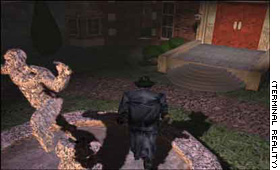|
|
| CNN WEB SITES: |

|
| TIME INC. SITES: |
| MORE SERVICES: |
| video on demand |
| video archive |
| audio on demand |
| news email services |
| free email accounts |
| desktop headlines |
| pointcast |
| pagenet |
| DISCUSSION: |
| message boards |
| chat |
| feedback |
| SITE GUIDES: |
| help |
| contents |
| search |
| FASTER ACCESS: |
| europe |
| japan |
| WEB SERVICES: |
The game engines of the not-too-distant future
|
August 21, 1998 by George Chronis and Willem Knibbe |
From... |

(IDG) -- Worried that every new action game or RPG for the foreseeable future will look like Quake II or Unreal? That proposition has crossed our minds here at PC Games. Despite the fact that id and Epic have crafted fantastic engines that have made major strides for 3D gaming, no gamer wants to see each new shooter looking like another mod of those games.
Promisingly, 1999 will see three new 3D engines revving up from the mechanics at Rebel Boat Rocker, 3D Realms, and Terminal Reality. Powering such heady-looking games as Prax Wars, Prey, and Nocturne, these engines will likely broaden gameplay dynamics while they provide healthy competition for the Quake II and Unreal clones.
Prax War
Shooter fans already know that a bunch of guys from the original Duke Nukem 3D team signed up with Ritual to do SiN, but less well known is that another cadre went on to form Rebel Boat Rocker (RBR). Prax War is RBR’s first child, and this first-person, 3D-only shooter has possibly the most radical new engine we’ve seen. With the exception of renderings, which are written in the C programming language, the Prax War engine is written entirely in Sun’s Java.
RBR chief architect Randy Pitchford says coding in Java provides a lot more flexibility than the more traditional Quake or Unreal engines. Examples of this flexibility include scaling polygons: As players pull back from an adversary, the polygon count will go from a high of 1,000 up close to 150 at a distance. This will allow RBR to “bring back the mow-down,” according to Pitchford, where you’ll face a platoon of up to 50 soldiers at a time.
Players will also be able to interact more fully with a majority of models in the game. See an AI-driven mech that would make your mission easier to accomplish? Just kill the driver and jump in. One thing Pitchford says he’s always wanted to do is set up a game server that can simultaneously handle CTF- and Rocket Arena– style mods. Prax War will be able to do this.
|
| ||
|---|---|---|
|
|
IDG.net home page | |
| Games.net home page | ||
| Download games from Games.net | ||
| Games.net's hardware news page | ||
| Games.net's game previews page | ||
| Games.net's game reviews page | ||
| Make your PC work harder with these tips | ||
| Reviews & in-depth info at IDG.net | ||
|
|
IDG.net's desktop PC page | |
| IDG.net's portable PC page | ||
| IDG.net's Windows software page | ||
| Questions about computers? Let IDG.net's editors help you | ||
| Subscribe to IDG.net's free daily newsletter for computer geniuses (& dummies too) | ||
|
Search IDG.net in 12 languages | ||
| News Radio | ||
|
|
Fusion audio primers | |
|
|
Computerworld Minute | |
Gameplay puts players in charge of a strike team of five commandos assigned to take out a terrorist menace. In multiplayer matches, players will be able to choose from any character model encountered in the game. Expect Prax War between next spring and next summer. Because we’re talking Java, there could potentially be Mac and Linux versions as well, but the jury’s still out on platform support.
Prey
Despite using the Unreal engine for Duke Nukem Forever (see below), 3D Realms has different plans for Prey, the story of a 27-year-old Apache who’s abducted to a massive alien mothership and must fight his way home. The Portal Engine is 3D Realms’ bet on the future (excepting Duke Forever, it’ll encompass the next four games beyond Prey) and is scalable to take advantage of the next two upgrades in CPUs from Intel: Katmai and IA-64.
So what’s the difference with portals? Instead of creating levels connected by individual rooms in one huge affair, the engine concentrates on making rooms (cells) independent zones, then linking them to other rooms through invisible portals. So, rather than forcing the game engine to process geometry data about the room you’re in and every room you have access to, the Portal Engine only processes data about the room you’re in and the portals you can see through.
According to Prey project leader Paul Schuytema, once your CPU isn’t forced to calculate all that extra geometry, resources are freed up to do more in the room you’re in. For example, in Prey, you can interact with every object—be it a TV remote-control on a coffee table or the wall of a warehouse. But because programmers have the extra resources, they can make interaction with every wall and rafter in the warehouse dynamic, not scripted. Shoot at different locations, and the results will be different—the whole warehouse may come down around you, or just the wall.
Portals can also be used in gameplay. In Prey, they’ll be linked to portable generators. A player drops one of these landmine-looking devices and it opens up a portal. Drop another generator, and there’s now a jump gate between the two portals. You can jump or shoot through the portals, and you can also use a rocket blast to blow other players through portals and into lava pits or other perils.
Since 3D Realms is looking toward the future with its Portal Engine, the baseline system requirement for this 3D-only game is a 266MHz Pentium II. Prey will have its own 3D audio format using MMX protocols and will support A3D and DirectSound. 3D Realms says the game should be ready in spring 1999.
Nocturne
Developer Terminal Reality -— known for Terminal Velocity, Monster Truck Madness, and MTM2 -— is hard at work on an engine that’ll bring a new level of realism to the genre. Nocturne, the name of both the game and its engine (known as Demon until trademark issues arose), will be the first game with volumetric lighting and fogging, says Terminal Reality president Mark Randel.
It’s a fancy way of saying that rather than shadows being pre-rendered as in current games, Nocturne will be able to cast shadows in real time from multiple light-sources. Walk under a streetlight while carrying a lantern, and you’ll cast two shadows. Set the lantern down and stand in front of it, and your shadow will stretch the length of the scene.
Fog works similarly. Rather than being static, it blows in and curls all around you. Just as quickly, another gust blows the pea soup away.
Such effects go a long way toward enhancing the game’s creepy, eerie atmosphere. Described by Randel as a cross between X-Files and Men In Black, Nocturne has you traveling to different locations to hunt down and eliminate werewolves, vampires, zombies, and other supernatural frights. As is the trend these days, it’ll incorporate some RPG elements. For example, your character will get better at certain skills as you progress.
While other plot and gameplay specifics were a bit hazy (the game’s not due til late next year), the demo we saw was impressive, especially since all the rendering was done in software. Nocturne will require an MMX processor, with a P166 targeted as the baseline system. You’ll need a Pentium II for hi-res effects.
